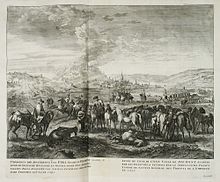
Back Belagerung von Cuneo German Siège de Coni (1691) French Assedio di Cuneo (1691) Italian クーネオ包囲戦 (1691年) Japanese Omleiringa av Cuneo i 1691 NN Beleiringen av Cuneo i 1691 NB Assedi 'd Coni dël 1691 PMS
| Siege of Cuneo | |||||||
|---|---|---|---|---|---|---|---|
| Part of the Nine Years' War | |||||||
 Siege of Cuneo 1691 | |||||||
| |||||||
| Belligerents | |||||||
|
|
| ||||||
| Commanders and leaders | |||||||
|
| Victor Amadeus II of Savoy | ||||||
| Strength | |||||||
| Data pending |
Garrison, + 2,500 relief force[1] | ||||||
| Casualties and losses | |||||||
| ~700–800[2] | Data pending | ||||||
The siege of Cuneo was fought on 28 June 1691 during Nine Years' War in Piedmont-Savoy, modern-day northern Italy. The siege was part of French King Louis XIV’s campaign against Victor Amadeus, the Duke of Savoy, who had sided with the Grand Alliance the previous year. The siege was an attempt to gain a foothold on the Piedmont Plain, thus ensuring Marshal Catinat's army could winter east of the Alps. Yet due to the incompetence of the two French commanders (in fact, General Vivien de Bulonde, because of decoded messages from Louis XIV to Catinat authorizing his punishment, has been proposed by some to have been the Man in the Iron Mask) – and a timely arrival of Imperial reinforcements – the siege proved a disaster, resulting in the loss of between 700 and 800 men. Although French forces had taken Nice in the west, and Montmélian in the north, Catinat's small, ill-equipped army was forced onto the defensive. Louis XIV subsequently offered Amadeus generous peace terms but the Duke, who had by now received substantial Imperial reinforcements from the Empire, considered himself strong enough to continue hostilities.